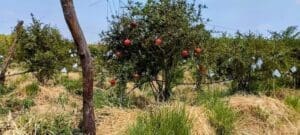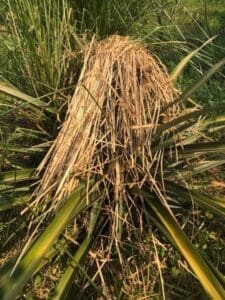
Ngô Đức Thọ is an engineer, and is the Coordinator for the Vietnam Vetiver Network and a TVNI farm advisor. He is also the founder and administrator of a very successful Facebook group — Vietnam Vetiver Farmers – that has some 10,000 members. I often visit the group page as it has some great information and thousands of vetiver related photos. The new ideas and ways of managing vetiver on small farms and gardens are being generated and put into practice by this group. Here follows Ngô Đức Thọ latest news (April 2024) from Vietnam:
“Due to the influence of unusual weather, currently, more than 70% of Vietnam’s territory is in the peak of the dry season with a hot and dry climate, high temperatures and intense sunshine for long periods of time without rain. There are areas that have gone 6 months without a drop of rain. The Northwest, Central Highlands, and Southeast regions are dry, lacking water, and irrigation lakes are dry. While the Mekong Delta provinces are suffering from saltwater intrusion and drought, the flow of the Mekong River is very low, not enough to repel saltwater intrusion. At the same time, there is a lack of domestic and drinking water in highlands and saltwater intrusion areas.
Long-term solutions to adapt to climate change are what we are aiming for. Using Vetiver grass in agriculture is a solution that we have implemented and continue to pursue for many years.
We can mention a few typical models that Vietnamese farmers are implementing, which have proven highly effective in coping with extreme, prolonged hot weather conditions.

The pomegranate farm in the Southeast (Tay Ninh province) has used vetiver grass grown symbiotically, planted around the base, and covered with grass leaves for nearly 3 years, which has brought positive results. The soil structure has changed, becoming more organic, more fertile, better water retention, richer in nutrients… Even though it is a dry time, grass and fruit trees still grow very well.

In Binh Thuan and Binh Dinh, coastal provinces, there is a Savanna climate with a short rainy season and a long dry season. The soil structure in this area is mainly sandy loam, which absorbs a lot of heat and makes the ground very hot. There was a time when it was over 70 C which we measured with an infrared thermometer. Vetiver grass has demonstrated its superiority over native plants. It is not affected by dry weather, does not die, but on the contrary grows well, and short-term plants and fruit trees grow very well thanks to symbiosis with grass. (see photo 3).
We use Facebook to communicate about vetiver with a very good reach. Social networks such as Facebook, Tiktok, or X, Youtube are the main communication channels. Articles with in-depth content, clearly explaining the principles of symbiosis, and the covering and drought-resistant effects of vetiver grass, receive a lot of attention and agreement from readers.

Heat can cause some fruits to be less productive and ripen quickly, such as pineapples and bananas. Therefore, farmers growing vetiver grass in gardens in Thua Thien Hue use grass leaves to cover the fruit, limiting direct sunlight, slowing down the ripening process and achieving higher yields (photo4).
Dak Lak Provincial Television Station (Central Highlands region) reported on measures to combat drought and nematode disease for fruit trees by growing vetiver grass in symbiosis with the crop. This news attracted more than 1,100 interactions, 115 shares and 89,000 views.”
Mine is in very small portion but i believe is Jesus Name i will put effort to have a big portion
Very informative. Thank you.